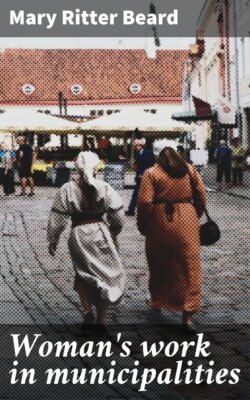Читать книгу Woman's work in municipalities - Mary Ritter Beard - Страница 11
School Buildings
ОглавлениеWhile thus interesting themselves in educational administration and the content of school curricula, women have not neglected the physical aspects of school buildings. The movement for sanitary school buildings in which women have sometimes led, instigated officials to lead, helped personally, or inspired janitors to act, has been followed up by the decoration of the buildings. The beneficial effect of artistic interiors on children, who spend so large a proportion of their waking hours in school buildings, is incalculable. Their physical comfort and their moral and artistic natures are advanced in a measure difficult to estimate.
Organized first for self-culture of a literary and artistic character, the expansive nature of club women has expressed itself in the extension of that acquired culture to the children in the schools. Volumes could be written if an attempt were made to record the stories of the efforts made by women to beautify schools and equip them with books for supplementary reading. That story is one of the best known of all and, for that reason, needs less attention at this place, not because it has been of little importance but because almost every hamlet and town has felt the influence of women in that direction. According to their incomes and their taste, they have sought to introduce as much beauty and harmony and as much literary and scientific appreciation as possible.
Believing that the school yard should receive at least as much care as the town cemetery, women have planted trees, seeds, and bulbs. For the interior of the school building, they have at times furnished an inexpensive photographic reproduction for a school wall and a piece of statuary, or expensive rugs and pictures, or a piano, and many times they have dominated the whole scheme of inside decoration and even the architecture itself.
Apparently women can build as well as suggest how schoolhouses should be built. Miss Alice M. Durkin of New York, who was recently given the contract to build Public School No. 39 in the Bronx, wonders why more women do not go into this work. She built a public school in Jersey City and another in Brooklyn. She employs between 600 and 700 men. In a competitive contest for the $250,000 extension to the Metropolitan Museum in Central Park, New York, Miss Durkin came out second and she was third in the competition for the New York Public Library.
That women have helped to secure better buildings and equipment, abundant testimony, not only from their own reports but from public men, shows. For a single example, under the leadership of Mrs. B. B. Mumford of Richmond, Virginia, former president of the Richmond Education Association, a magnificent high school building costing $500,000 was secured. In innumerable letters comes the modest word that “we worked hard until we got a high school in our town” or “we secured a much needed addition to the school building” or “we are trying to raise the money for a new building.” In one instance a high school was only made possible by the offer of the women to buy the furniture and other needed equipment if the town would erect the building.
In order to maintain high standards of physical equipment in their schools club women have often acted as school inspectors. Mrs. George Steinmetz of Pekin, Illinois, is one of these and of her election she writes: “At our last election for school inspectors two club women were nominated on an independent ticket. I was elected, and I am the first woman in our town to fill that position, but I hope others will be elected next year. The ticket brought out a large vote, and resulted in a majority vote for the building of a new high school and a new grade school and the remodeling of ten others.”[8]
